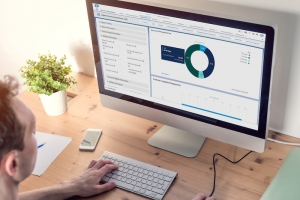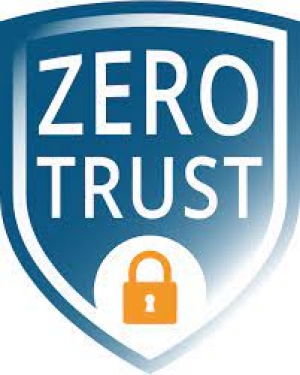عرض العناصر حسب علامة : السحابة الالكترونية
هل سيكون محاسبك القادم روبوتًا؟
تتقدم العلوم والتكنولوجيا بسرعة باستخدام الروبوتات. في الواقع، يشعر بعض الموظفين بالقلق من اختفاء العنصر البشري تمامًا من أدوار العمل الرئيسية. في عالم المال، تستعد برامج المحاسبة لتصبح أسرع وأقل تطلبًا للعمالة في السنوات العديدة القادمة.
معلومات إضافية
-
المحتوى بالإنجليزية
Will Your Next Accountant Be A Robot?
Jan 14, 2019 | C-Suite, Salesforce Account Executives, Technology Innovation
facebook sharing buttontwitter sharing buttonlinkedin sharing buttonsharethis sharing button
Science and technology are rapidly advancing with the use of robots. In fact, some employees are worried about the human element disappearing completely from key business roles. In the financial world, accounting software is poised to become even faster and less labor demanding in the next several years.
One thing remains certain, as accounting technology evolves, so will the role of the accounting team. However, there remains a need for actual accountants to make sense of finances, even in the midst of innovation.
a man looking at an accounting seed business report
The Tools of Change
Instead of thinking that technology will eliminate or reduce human involvement, look at it as a resource that expands the scope of the financial expert. Accounting practices haven’t dramatically changed in the last few years, but technology has revolutionized how efficiently accounting processes can be done. For an accounting team, remaining valuable means embracing the tools of the future including automation, the cloud, and artificial intelligence.
Automation allows software to streamline key accounting processes such as billing and payments because human interface is heavily reduced, eliminating the need to re-enter data to produce repeatable tasks. This minimizes the workload, increases data integrity, and makes tasks related to bookkeeping easier. Due to this advantage, automation will continue to increase. In a report by Accenture, it’s estimated that by 2020, 40 percent of transaction accounting will be automated. However, recording transactions is only one aspect of the accounting team’s role. Another crucial role of the accounting team is that of advisors, using the information gained from financial transactions to provide insight which can improve business strategy.
As automation progresses, the repetitive aspects of journal entries become faster and less reliant on human action, but this means that financial experts can work faster too. Accounting teams will spend less effort putting in the numbers and more time analyzing them.
The Cloud
The Cloud is already a leading innovation as more and more companies rely heavily on cloud-based applications and services. In the same report compiled by Accenture, up to 85 percent of CFOs are planning future investments in the cloud. Cloud-based platforms and applications will continue to surge in popularity, overtaking older legacy systems because of their flexibility, speed, and accessibility, as well as their ability to be quickly upgraded. We will see core functions like analytics and reporting shift even further towards cloud computing programs, which includes accounting. This is happening now and will continue to accelerate, giving accounting teams more tools and opportunities to work with.
The cloud lets financial data be accessed by staff anywhere, collected from other cloud-based software, and stored in a single solution, like Accounting Seed. This gives businesses more control over their financial management while expediting the process as a whole. Finances can be updated and managed all online and in near real-time through automation too. The cloud will be a major vehicle in helping accounting teams get results closer and closer to actual real-time which will become a major demand for business leaders. As more businesses use the cloud, and automation continues to improve, accounting teams can optimize their workflow and provide better insight because the key information will be more readily available.
Artificial Intelligence (AI)
Artificial Intelligence (AI) continues to show it’s prominence in the next generation of business software. In the accounting world, we’ll likely to see this increase through such technology as Robotics Processing Automation (RPA). RPA is software that combines machine learning capabilities and AI to automate rule-based processes. This can range from processing transactions to generating automatic responses. The ability for a program to self-learn improvement opportunities or prevent mistakes is desirable in accounting as it reduces the amount of time spent on basic processes of transaction recordings and distributions. This doesn’t render accountants useless. Rather, AI helps financial experts do their job more efficiently because no time is wasted. AI makes the job faster, it doesn’t destroy it.
You’ll Still Need Accountants
Ultimately, accounting software is a tool. You still need to know how to use it, and even then, it requires detailed analysis to make use of the data. As technology develops, the technical aspects of accounting become easier and faster, but this simply means the accounting team can serve more a group of guides or consultants (which is ultimately what you really want).
Total reliance on AI or other technology, in general, is not the solution for progress. Removing the insights of human accountants is unwise. Even with the raw processing power of an automated, cloud-based system, good direction from the human is still necessary. Software can’t yet define strategies for cutting costs or provide insight into how to conserve more revenue to reach business goals. It’s up to the accounting team, harnessing the technology, to be the brains behind the machine.
The Evolution of Accounting
With the accounting team’s role evolving more towards analysis and strategy, accountants will need to collaborate more closely with different professionals such as software specialists. In addition to financial analysis and advising, accounting work may grow to report on the effectiveness of tools and individuals in gathering financial data or for quality control. The accounting business will change, but this has the potential of expanding the role of accountants. For the accountant team, mastering the latest technology trends and embracing innovation will empower their career to new heights and ensure their continued relevance.
نصائح حول الانتقال الوظيفي لـلمحاسب القانوني ومتخصصي الضرائب
اليوم وبعد مرور أكثر من عام على انتشار الوباء، يشهد الاقتصاد تقدمًا وقد اقترب موسم الضرائب من نهايته، وقد يكون العديد من المحاسبين مستعدين للبحث عن فرصتهم الوظيفية التالية.
معلومات إضافية
-
المحتوى بالإنجليزية
Given the new landscape, CPAs and other tax professionals may ask what steps can you take to grow your career and land your next opportunity.
Now that we’re more than a year into the pandemic, tax season has (finally) come to a close, the economy is on the upswing and many accounting professionals may be ready to search for their next opportunity. Here are a few ways CPAs and tax pros can plan their next move.
Sign up for our FREE email newsletter
Don't miss out on our best content.
Enter email address *Enter email address
Sign up
Education is Key
It may seem basic, but education and attaining credentials go a long way in the accounting profession. Those aspiring to explore a new role should consider the education and certification requirements of their chosen path.
For many professionals, getting their CPA license is a goal and part of the natural career progression. Obtaining this certification can qualify you for many different career opportunities, from within an accounting firm to leading a business across industries, as well as to help you stand out to employers and industry recruiters.
Easily File and Deliver 1099 and W-2 Forms Online
Efile4Biz offers all-inclusive print, mail and e-file services for quick, efficient and secure e-filing of 1099 and W-2 forms. Everything is done online, eliminating the need for software or paper forms.
Get started today!
Depending on your long-term goals, you might consider the CMA (Certified Management Accountant), a global certification for management accountants and finance professionals, or working towards your CGFM (Certified Government Financial Manager), a professional certification awarded by the Association of Government Accountants (AGA) that demonstrates competency in skills like governmental accounting at the federal, state, and local levels. Not only do additional certifications give you an advantage on other job applicants but pursuing them ensures that you’re consistently up to date on the latest information and increases your knowledge base.
And the education doesn’t stop there. In today’s job market, a huge differentiator is knowledge of the latest technology, including the cloud, AI and automation, and practical applications for your role. More and more companies are adopting these technologies and weaving them into everyday processes.
As a result, the need to upskill or reskill has dramatically accelerated. By getting ahead and educating yourself on these hard skills like data analysis and ERP adeptness, it’s possible to stand out among a sea of applicants.
Attend Events (Virtually)
Prior to COVID-19, it may not have been feasible to attend an event or conference, due to cost or lack of time travel. This meant that there were fewer opportunities for less experienced or more junior associates to grow and network with industry thought leaders.
Today, attending events looks a little different. In lieu of traditional conferences, many organizations have switched to virtual platforms – making professional development or networking opportunities more accessible for many. By signing up and learning from thought-provoking industry executives, you can gain insights on the future of the industry and what companies are looking for in the leaders of tomorrow.
Attending virtual events is also a great way to network with peers. Many conferences offer scheduled breakout rooms, giving you the opportunity to engage and participate in discussions with peers and industry leaders. Topics may vary, but sharing your insights and ideas could position you as an expert.
Another way to network virtually is to be active on social media. Consider posting your thoughts and what you hope to experience at the event, using specific hashtags and posting on the event page or your own social media channels. By doing so, you have the ability to spark great conversation with other potential attendees and industry peers and to build your own professional network.
After the event takes place, you can also share lessons learned – this could take the form of a social media post or written article that can be shared on platforms like LinkedIn. There is also an opportunity to share your learnings with members of your firm, which with further exemplify your leadership skills.
Continuing To Develop Your Leadership Role With EQ
Many companies have changed the way they hire and onboard employees because of COVID-19. Prior to the pandemic, leaders may have only been assessed by their hard skills, like developing efficient financial reporting methods. But now the leadership profile has taken a turn, focusing on behavior training and a high emotional intelligence (EQ).
In order to take the next step in your career, it’s critical to focus on your emotional intelligence. Leaders in today’s climate need to be able to better connect with teams and employees, as many people want to work in a place where they feel safe.
When looking for a new career or position, you should be prepared to discuss specific moments in time that highlight instances when EQ and ability to connect with others helped move a situation forward.
While this is a skill that’s typically intrinsic, it is possible to develop your EQ through behavior training, practicing self-awareness and actively listening. Today, these are the skills that matter most in the workplace.
Conclusion
While many employers provide professional development and training resources to their employees, it is important that you take your future into your own hands. Immersing yourself in outside learning opportunities, like virtual events, and continuing to educate yourself on the industry and necessary skill sets relevant to today’s times are critical to advancing your career.
When looking to take that next step, make sure you show recruiters your efficiency in hard skills – like those that come with certifications – and knowledge of technology. Second, but equally as important, show them the soft skills that make you stand out from other applicants – like your willingness to stand up and share lessons learned and the ability to connect with fellow employees at all levels.
تعظيم عائد الاستثمار من خلال تبسيط إدارة المستندات
كل يوم تقضي أنت وعملائك الكثير من الوقت في مهام شاقة مثل الطباعة أو الفاكس أو البريد أو النسخ أو حتى مجرد العثور على المستندات ذات الصلة. يمكن أن يستغرق هذا، في المتوسط، ما يصل إلى تسع ساعات أسبوعيًا لكل موظف. قد يستغرق الشخص المحترف ما يصل إلى 18 دقيقة للعثور على مستند يدويًا ويمكن أن يقضي ما يقرب من نصف أيام العمل في محاولة العثور على المعلومات التي يحتاجون إليها للقيام بعملهم. كل هذا الوقت يمكن أن يعادل ما يصل إلى 468 ساعة في السنة.
معلومات إضافية
-
المحتوى بالإنجليزية
Maximize ROI by streamlining document management
By Jason Schow
November 30, 2021, 10:33 a.m. EST
4 Min Read
Facebook
Twitter
LinkedIn
Email
Show more sharing options
Every day you and your clients spend a lot of time on tedious tasks like printing, faxing, mailing, copying or even simply finding relevant documents. This can, on average, use up to nine hours per week per employee. It can take up to 18 minutes for a professional to find a document manually and can spend almost half of their working days trying to find the information they need to do their job. All of this time can equate to up to 468 hours per year.
When you take paper out of the equation, your company workflow automatically improves. Collaboration between team members and clients becomes more simple, and information is at your fingertips no matter where you are. When you’re able to work more effectively, clients will likely notice the difference in the speed of service provided.
“Access to tools and documents that enable good job performance” ranks No. 2 on the list of the top five most broken processes, according to a survey in Nintex’s Definitive Guide to America’s Most Broken Processes. That’s why you or your firm may have a pretty big margin of improvement. The survey found that 43% of respondents reported trouble with document approval requests and document sharing, and just over 30% said they struggle managing different versions of documents.
Advances in Tech brings together some of the latest software and technologies that are helping the industry move forward.
ACCOUNTING TODAY
Another recent survey from McKinsey & Company found that 40% of respondents will either need to be fundamentally retrained for the challenges of their job or replaced to make up for their organization’s skills gap.” However, only 15% of respondents plan to address this issue within the next two years. They also found that organizations that don’t use technology for their business workflows have an even harder time finding talent. About 42% in that group reported they’ve “stuck with the status quo because it’s difficult to source the talent they need.”
Further, document management is particularly sensitive in the accounting industry, as documents are central to the profession.
Improve workflow by going paperless
The average worker in the U.S. uses 10,000 sheets of paper annually, making up around 70% of a company’s total waste. Paper is also one of the largest business costs with around $120 million spent on printed documents every year — just on paper. When moving to a paperless office, a big percentage of that expense is removed and as an added bonus, it gets a lot easier to keep track of important documents.
After making the decision to go paperless, transitioning to the cloud is the next step, which can have unexpected challenges like unreadable uploaded documents. What is even better than sharing scanned documents with clients is sharing fillable PDFs so they can fill in information and sign directly from their devices — without printing.
Following the three steps below is a really good way to start a paperless environment at work:
Invest in a cloud-based software program. Cloud technology will permit you to build an effective document management process. It provides the ability to access files remotely to work from anywhere, anytime with a more flexible schedule.
Scan and upload your essential documents. Digitizing your documents is a necessary effort upfront, but it will bring a clear improvement in the long run.
Shred old documents. Once papers are in the cloud and easily accessible online, there’s no need to keep a hard copy. To stay organized, be sure to shred copies you no longer need.
Recognize the importance of security precautions
Each week, an average of five to seven accounting firms report a security breach. Keeping client data secure has always been a top priority for an accounting firm, and that’s especially true if you’re moving to a digital document management system. However, even firms still using paper need to take security very seriously. Hard copies can easily end up in the wrong hands because of an innocent mistake.
As mentioned above, be careful with paper copies and shred sensitive paper versions of uploaded documents. It’s a great idea to look into hiring IT professionals and experts to keep you up to date on the latest tech trends and keep your firm safe from cyber attacks and security breaches. If budgets are tight, you can perhaps hire a contractor to help.
You can also create a document security process with your team. Here are some best practices to help you get started:
Restrict document access to authorized personnel only. Make sure to regularly check who has access to what documents, especially for sensitive client data.
Change passwords often and don’t use the same one for everything. Be sure to never use a personal password to protect professional data.
Update passwords and access after employees leave or retire. Never leave passwords written on papers around the office — instead, consider investing in password manager software that will help keep important information in the hands of the firm and be easily located.
Regularly back up your documents. This will ensure you don’t lose updated versions of important documents and your files won’t be deleted if you lose a device. They will be available in the cloud and not solely stored on a certain laptop or phone.
Use a virtual private network. When you are using a wireless network that is not habitual, using a VPN can be a great way to encrypt your data and keep it safe.
Look into endpoint security software. Endpoint protection provides security at the entry point of all firm devices like desktops, laptops and mobile devices. It can alert firms if a document gets shared outside, stop external cyberattacks, and more.
As an accounting firm, finding the document management system that works best for you should be a priority since it will shape how your entire firm runs. By investing in the right tools, the ROI will be evident.
فرق المالية تتبنى أخيرًا فوائد التكنولوجيا
فرق المالية في رحلة اكتشاف مثيرة. لقد بدأوا أخيرًا في تبني فوائد التكنولوجيا -وهي خطوة طال انتظارها، وفقًا لأنيش كابور، الرئيس التنفيذي لشركة AccessPay، وهي شركة متخصصة في الدفع عبر السحابة الإلكترونية.
معلومات إضافية
-
المحتوى بالإنجليزية
Finance teams finally embracing the benefits of technology
Anish Kapoor, CEO of AccessPay, explains why automation will be increasingly crucial to organisations over the next few years
Author
Rob Griffin
Date published
August 9, 2021
Categories
People Business
Technology
Finance teams finally embracing the benefits of technology
Finance teams are on an exciting journey of discovery. They are finally starting to embrace the benefits of technology – a move that is long overdue, according to Anish Kapoor, CEO of AccessPay, a cloud-based payment specialist.
“Finance teams have lagged behind other areas of the business in the use of technology,” he says. “Marketing and sales have been using tech to become more efficient for 20 years.”
He suggests that the decision of finance teams to accelerate their adoption of technology is due to increased compliance burdens in the face of changing requirements from regulators and greater demands placed on businesses by consumers.
“They have prioritised investment in other areas over themselves, but now the biggest gains from automation are in the finance function,” he says.
The benefits are clear, according to Kapoor. Automating as many tasks as possible will free up time for other revenue generating work – or even to guard against future economic shocks.
“Business will be under pressure to cut costs due to lower revenues or paying back loans after Covid-19,” he warns. “Finance functions won’t be exempt from these problems.”
The finance function, therefore, will need to find innovative ways to keep manage cash to ensure financial stability and monitor payment authorisations in the most cost-effective way possible.
“It’s important that businesses start investing for the long-term and make significant structural changes,” says Kapoor. “More organisations are starting to bite the bullet on these decisions.”
Kapoor believes there is plenty of scope for development as many of the core financial operations have failed to keep pace with a fast-developing and more connected world.
“Getting data to and from your banks is at the heart of what finance teams do and yet the technology hasn’t changed in 20 years – when we moved from telephone and branch banking to internet banking,” he says.
This is something that AccessPay is keen to change.
Resources & Whitepapers
Professional Services Why Professional Services Firms Should Ditch Folders and Embrace Metadata
2 Vital keys to Remaining Competitive for Professional Services Firms
Accounting Firms Turn Accounts Payable into a value-engine
Making Tax Digital Digital Links: A guide to MTD in 2021
“We are a trusted partner to global banks,” he says. “Customers use our technology to create a secure, fully digital connection between banks and their ERP [enterprise resource planning], HCM [human capital management] and treasury systems.”
Citing corporate customers such as ITV and Imperial College London, he insists digital connections not only result in cost savings, but also provide data in real-time.
“They can save hundreds of thousands of pounds in fees, bank charges and financing costs, by managing their cash better,” he says.
Driving finance forward
In recent weeks, AccessPay has become available to Sage users through their online marketplace, with it sitting alongside other approved independent software vendors to enhance back-office systems of Sage customers.
Earlier this year, it also announced a partnership with Yapily, the open banking infrastructure provider, to provide treasury solutions for corporates. The tie-up will provide real-time visibility into cash positions and transaction flows for thousands of UK businesses. Kapoor believes such agreements illustrate how technology has become a must-have for the finance function.
“Five years ago, we could maintain the status quo but now all businesses are under pressure to do more with less and the only way you can do that is with technology,” he says. “Finance teams are under huge pressure to deliver more detailed information, with analytics, faster to the business with less resource.”
The changing demands are one of the key driving factors. The sheer amount of data they need to process makes automation a crucial component of success.
An important trend within payment provision is corporate banking becoming more digitized within day-to-day operations.
“More lending decisions are made using data pulled from ERPs and banks, while more services are only available digitally, such as low-cost international payment services,” says Kapoor. For many firms this requires a change of mindset. “Finance teams need to be moving to a more digital connection with their banks, to allow them to keep pace with these changes,” he adds.
Kapoor insists this is where AccessPay can play a role. Helping to automate and digitise banking operations can free up 50 percent of a finance team’s time, he says. “It also gives them access to data with which to make better business decisions and allows them to access the new range of digital first financial services.” - البلد الأردن
الخطوة التالية في الأمن السيبراني: "الثقة المعدومة"
ذات مرة، تجولنا في العالم الرقمي. كان لدى الشركات ضوابط أمنية محيطية (لحماية شبكتها وبياناتها، وبمجرد أن تمسح حركة المرور نقطة التفتيش الفردية أو "الجدار الحدودي\ border wall “، يمكنها الاتصال بحرية داخل الشبكة دون مزيد من عمليات الفحص. هذا عمل بشكل جيد لبعض الوقت. ولكن نظرًا لأن الإنترنت والشبكات أصبحت أكثر تعقيدًا، وتوزيعًا، ويوجد مخاطر بطبيعتها -خاصة مع الترحيل إلى السحابة -لم يعد بإمكان الشركات الاعتماد على حارس البوابة وعمليات التحقق لمرة واحدة بعد الآن. يتطلب انفجارنا الحديث للأجهزة وعملنا المعقد على الويب للشبكات المترابطة ضوابط أمنية أكثر ذكاءً وموثوقية -عندما أصبح عالمًا تنعدم فيه الثقة، اعتمدنا فلسفة انعدام الثقة.
معلومات إضافية
-
المحتوى بالإنجليزية
The next step in cybersecurity: ‘Zero Trust’
By Avani M. Desai
September 22, 2021, 9:00 a.m. EDT
4 Min Read
Facebook
Twitter
LinkedIn
Email
Show more sharing options
Once, we navigated the digital world on a “trust but verify” policy. Companies had perimetric security controls (e.g., a firewall) to safeguard their network and data, and once traffic cleared that single checkpoint or “border wall,” it could freely communicate within the network without further checks. This worked well, for a time. But as the internet and networking became more convoluted, distributed, and innately riskier — especially with the cloud migration — companies couldn’t just rely on a gateway guard and one-time validations any longer. Our modern explosion of devices and complex webwork of interconnected networks demand much savvier and more reliable security controls — when it became a zero-trust world, we adopted a zero-trust philosophy.
Zero trust is a concept and security framework introduced by Forrester Research years ago: “Never trust, always verify.” To achieve zero trust security, there are three guiding principles, as outlined by software company Varonis:
Require secure and authenticated access to all resources: Authenticate and verify all attempts to access the network, assuming they are threats until proven otherwise).
Adopt a least-privilege model and enforce access control: Limit user access to only the access each needs to do their job, thereby limiting the scope of a potential breach.
Inspect and log all activities using data security analytics: Introduce proper individualized baselines per user account that will detect abnormal behaviors based on perimeter telemetry, data access, and user account behavior).
In short, zero trust requires all users, within and outside a network (be it local, in the cloud, or hybrid), to be authenticated, authorized and validated continuously for security configuration and posture before being given (or retaining) access to applications and data. To verify user identity and uphold the network’s security, this framework relies on advanced technologies — such as multifactor authentication, identity protection, endpoint security technology, etc. — to achieve real-time visibility into user credentials and attributes. This added layer of protection becomes even more essential as companies increase their network endpoints, expand their infrastructure, and are exposed to increasingly sophisticated attacks by rogue (insider or compromised) credentials.
Greater security and better auditing
Inflo Digital Audit: The profession's first end-to-end digital audit platform
Do more with data, automate compliance, and improve your value with Inflo’s Digital Audit -- the accounting profession's first data driven audit solution...
SPONSOR CONTENT FROM INFLO
With that being said, successful establishment of zero trust depends on how quickly and effectively each organization can implement end-to-end, multi-cloud security solutions and uphold the requisite methodologies. Because of the added risk when dealing with any cloud deployments, endpoint security must stay top-of-mind during these migrations to satisfy compliance models such as the GDPR and the NIST Cybersecurity Framework.
To protect data — especially cloud data — software company MobileIron’s 10-point security audit checklist lists the best practices for designing a data security and access control framework on every endpoint across borderless enterprises:
Enforce device encryption and password protection.
Prevent business apps from sharing data with personal apps.
Automatically delete business data from compromised devices.
Tunnel business traffic without tunnelling personal traffic.
Stop unauthorized devices from accessing business cloud services.
Stop unauthorized apps from accessing business cloud services.
Detect and remediate zero-day exploits.
Provide rich security controls across a variety of different operating systems (e.g., Android, iOS, macOS, and Windows 10 now support unified, cross-platform security solutions).
Certify for device security (e.g., Common Criteria Protection Profile for Mobile Device Management).
Certify for cloud security (i.e., SOC 2 Type 2 and FedRAMP).
Already a boon to internal security, a company’s implementation of zero trust also forecasts favorably when it comes to auditing. As noted in Internal Audit 360, “Zero trust eliminates traditional security tooling implementation nightmares, yet provides the fine-grained controls security practitioners seek, the auditability auditors need, and the network flexibility IT operators want.”
Inherently providing visibility and automation, zero trust streamlines compliance by first evaluating and then logging (with detail) each access request. Orchestration tools that are already working to detect suspicious user behavior or potential cyberthreats also create an effortless chain of evidence that paves a smooth audit trail.
Given that each asset in such a network is “fingerprinted” before it’s allowed in the system (and that each is constantly getting re-verified), zero trust networking enables organizations to easily demonstrate how their data has been accessed, collected and used. It also encourages another critical element of auditing data and systems security: data flow mapping, or understanding where an organization’s data is, and how and with what it’s communicating. This superior visibility provided by a zero-trust network supports compliance initiatives and enables auditors to achieve better insight into how and where the data flows, how users and workloads are protected, and how the system is overall secured.
The benefits to this approach are clearly laid out — the amount of transparency and meticulous control permitted by zero trust help mitigate the risk of security breaches and exploitations, as well as that of negative audit findings. It stands to reason that, as the internet continues to evolve, with more and more processes turning to digital alternatives, the focus on protection of data will only increase and zero trust methodology should absolutely be discussed as an option for every organization.
أخطاء الأمن السيبراني التي ما زالت شركتك ترتكبها
كما أوضحت الانتهاكات الأخيرة والغرامات الرئيسية ذات الصلة التي فرضتها هيئة الأوراق المالية والبورصات، فإن الأمن السيبراني ليس شيئًا يمكن للمستشارين الماليين والمحاسبين تحمله لمعالجته مرة واحدة في نشرة السياسة، وعدم إعادة النظر فيه أبدًا.
معلومات إضافية
-
المحتوى بالإنجليزية
As recent breaches and related major SEC-imposed fines have made clear, cybersecurity is not something that financial advisors and accountants can afford to address once in a policy handout, never to revisit.
Indeed, breaches keep occurring and mistakes keep happening because of non-adherence to firms’ cybersecurity policies and because of a lack of oversight and enforcement of those policies. This has become more true over the past year or so as firms have shifted operations and applications to cloud-based environments. The financial services industry is a long way from being cybersecure.
Wes Stillman
Forewarned is forearmed. Here are the most common cybersecurity mistakes that advisors and accountants are still making.
Misunderstanding the cloud
Overestimating the protection offered by the cloud and software as a service (SaaS) applications is still a key mistake. The cloud generally offers security for data and documents stored within it, but it is not a cybersecurity solution.
Accounting Power: The Premiere Professional Accounting System
Increase profitability, and build stronger bonds with your clients. Accounting Power includes all the capabilities not found in other cloud-based...
SPONSOR CONTENT FROM ACCOUNTANTSWORLD
When information is used outside of the cloud, there are no guarantees. Owners of RIAs and accounting firms should be concerned with how, when and where documents and applications are accessed — regardless of where they are stored. Information that is accessed, downloaded and used on unsecure, unencrypted devices can potentially expose the firm to cybersecurity issues.
Low cybersecurity awareness
Another major blunder firms make is assuming that employees are equally up-to-date on what the cyberthreats are and how to protect the firm from them. Unless firms work actively to create a culture of cybersecurity awareness, this is never the case. Security threats are constantly evolving as the sophistication of the bad actors increases.
Servers and hard drives stand inside pod one of IBM's Softlayer data center in Dallas.
TECHNOLOGY
The case for 'buy' when it comes to your firm’s IT system
September 23, 2021 12:23 PM
A firm owner can elevate the level of cybersecurity awareness in their existing culture by leading through example with ongoing verbal, written and electronic reminders. Budget time in team meetings to address these issues and consider bringing in outside consultants from groups like Infosec or KnowBe4 for occasional briefings, training or updates.
Lax enforcement of security policies
As the SEC showed with its sanctions and collective $750,000 in fines against Cetera, Cambridge and KMS Financial Services, cybersecurity is not just about instituting comprehensive policy, but about meticulously enforcing it. When a firm allows data to be accessed using any unsecure, unprotected device or application, it is exposing itself to real cybersecurity issues.
For example, an RIA may have an encrypted, password-protected email system. But once the firm email is synced to an unprotected device, the email becomes unsecure and the entire firm is potentially exposed to malware and phishing viruses.
SEC entrance - Bloomberg News
REGULATION AND COMPLIANCE
SEC fines 3 independent brokerages a collective $750K over email hacks that hit thousands of clients
September 1, 2021 2:01 PM
Today’s firms should consider secure identity management platforms that minimize the need for passwords by using single sign-on with adaptive multifactor authentication (MFA). In fact, MFA and end-device protection should be non-negotiable, particularly in remote work environments where users can access firm and client data through personal devices.
Firm owners need to keep cybersecurity management at the forefront by continually asking themselves, "Where's the data?" Remember, the issue is often not about storing data or email inside the firm. The increased risk can happen when information leaves the safe environment and ends up on unprotected personal devices, such as laptops, tablets and mobile phones — all of which are vulnerable to data breaches and cybersecurity attacks.
Client service overriding client security
It is natural to want to help clients with requests that seem to merit an immediate response. But excellent client service also includes policies that validate these requests to ensure they are legitimate.
Advisors must have procedures for validating email and telephone requests for wire transfers and for identifying and confirming clients. For example, a client who has forgotten their account login can be directed to re-register themselves and answer their own security questions rather than being given a password prompt or other personal information over the telephone.
Delegating cybersecurity/IT oversight to employees
There is too much at stake to continue delegating cybersecurity and IT oversight entirely to the staff member who is the firm's default technology expert. Cybersecurity threats are increasingly sophisticated, and the regulatory environment is evolving, too. Ultimately, it is the business owner's responsibility when something goes wrong.
Putting checks and balances in place serves to protect the firm owner, as well as to monitor how IT policies and procedures are executed. Owners of RIAs and accounting firms also need to know and document who is logging in to what, when and where in the event of a cybersecurity breach.
Skimping on the cybersecurity budget
Cybersecurity management requires commitment of time and resources. Unfortunately, many advisors and accountants fall short when budgeting for this, which increases their firm's exposure to a potential breach. Firm owners need to consider cybersecurity as part of their firm's larger risk management budget and as an investment in brand protection and cost avoidance. For those with some security measures already in place, a good rule of thumb is to consider their annual IT budget and add on an additional 25% for cybersecurity protection, in addition to ongoing training and policy management.
3 مفاتيح تقنية لتمكين المحاسبين
معلومات إضافية
-
المحتوى بالإنجليزية
3 tech keys for empowering accountants
By Clayton Weir
September 10, 2021 10:43 AM
Facebook
Twitter
LinkedIn
Email
Show more sharing options
Much like every business vertical, accounting has seen its fair share of disruption as a result of the COVID-19 pandemic. And although digital transformation efforts have pushed innovation forward in many industries, accountants, by and large, unfortunately have to deal with fractured processes and outdated tools from pre-pandemic times. Not only do accountants have to tackle daily tasks with antiquated technology, but they have to find ways to make this tech meet the modern demands of today’s financial industry. And as the world around them continues to evolve and modernize, accountants are understandably struggling to keep up.
With that in mind, it is time for banks to allocate more attention and resources toward revamping their accounting infrastructure. Here are a few areas in particular that they need to focus on in order to make this happen.
Cloud migration
technology-and-telecom.jpgWith the number of tools that accountants are forced to deal with on a daily basis, remote work is a nightmare for those who are still forced to work with on-premise infrastructure. Moreover, given a significant portion of the financial industry still relies heavily on this “traditional” technology, on-premise is one of the foremost hurdles that is holding accountants back today. That said, the fix is quite simple: adopt the cloud.
By leveraging a cloud-based infrastructure, businesses can immediately boost the efficiency of their accounting teams by giving them easy, instant access to the data and solutions they need from anywhere. Additionally, it can also make onboarding new tools and processes far less painstaking than doing so with on-premise legacy systems.
Embrace automation
With CFOs and accounting teams now expected to participate more fully in business strategy and other non-finance tasks, the amount of time these teams have to engage in manual tasks continues to shrink. And as such, calls for greater automation within finance departments continue to grow.
According to a guide produced by Sage, 93% of finance workers say they would be happy to have tech do their daily accounting tasks. In addition, as budgets remain tight and workforces are continuously expected to do more with less, empowering accounting teams with automation will be pivotal to business efficiency and overall success.
Choose fintechs wisely
No two finance departments are exactly the same. So it is imperative that businesses take a step back and consider their needs properly before adopting tools and processes. Sure, a tool might seem to make sense on the surface, but what if it actually complicates things or makes tasks more challenging? All too often businesses jump into the fintech pool without fully understanding what their needs are and what they need to solve them.
Accountants have incredibly full plates to begin with. And without the support infrastructure and tools they need to juggle these tasks, it is virtually impossible for them to keep up with modern demands. Therefore, businesses need to work in close consultation with finance teams to identify their most pressing needs and find the solutions that are best tailored to them. Granted, with a global remote workforce, this may seem like a daunting prospect. By getting all of their ducks in a row early, not only will businesses be able to make the onboarding process far easier for their accounting teams, but they will also save valuable time and money down the road.
Accountants are integral to helping businesses achieve financial success. And with that, the time has come for these teams to be supplied with the modern tools that their work deserves. Without it, accountants will continue to struggle to meet their full potential and will not be able to help businesses achieve the growth they are looking for.
كيفية تسريع نمو الأعمال بمساعدة التكنولوجيا
لقد غيرت التطورات التكنولوجية التي تحققت على مر السنين الطريقة التي تتم بها الأعمال التجارية الى الأفضل، إن سوق العمل مليء بالمنافسة مما يجعل اكتساب ميزة تنافسية على منافسيك أولوية في بيئة اقتصادية صعبة. فتحقيق اقصى استفادة من أحدث التقنيات سيساعدك في تسريع نمو أعمالك حيث يمكنك تأسيس مكانة ثابتة.
إعادة تفكير المحاسبين في استخدام التكنولوجيا السحابية
معلومات إضافية
-
المحتوى بالإنجليزية
Pandemic prompts accountants to rethink use of cloud technology
By Michael Cohn
April 21, 2021, 3:35 p.m. EDT
5 Min Read
Facebook
Twitter
LinkedIn
Email
Show more sharing options
COVID-19 has been forcing accounting and finance teams to work remotely since last year, and that’s prompting reexaminations of how to use cloud technology for financial reporting in the future.
A report, released last month by the Institute of Management Accountants and the financial technology company Workiva, surveyed approximately 200 financial reporting professionals on their experiences and found that before the pandemic, their organizations placed a fairly low priority on technology-based financial reporting solutions. Two-thirds indicated they were behind other internal teams in competition for resources. About 30 percent of the respondents expressed interest in a technology-based solution for various activities around the documenting of management review processes and judgment areas. Approximately one out of five respondents said they have changed their prioritization or budgets for technology-based corporate reporting solutions for 2021 and into the post-pandemic period.
The pandemic forced most companies to shift toward a work-from-home environment last year, and that included their accounting department. While many employees have since returned to their offices at many organizations, others are continuing to do their work remotely. Despite the initial challenges, remote technology has mostly helped accounting and finance employees work safely from home, but it has also raised the question of whether companies should continue to rely on cloud technology after the pandemic eventually subsides.
“What we found out is that, not just with the anecdotal information that we were hearing, is that financial reporting teams are able to get the job done during the pandemic,” said Shari Littan, director of corporate reporting research and policy at the IMA, who co-authored the report. “They felt that they had adequate tools for some areas that are more challenging than others. Inventory is one of them. Revenue assessment is another. But by and large, they felt that they could get the job done. What we wanted to know is this going to change your movement toward adoption of more elegant and efficient solutions? And what we found is that there is an appetite for more.”
The survey respondents seemed to prefer new systems for two areas: control ownership and succession, and assessing revenue expectations. “The succession part is really where we’re really seeing some interest,” said Littan. “One thing a cloud-based or collaborative platform can do is automatically assign who is going to oversee what and who is the second in command, someone else who can step in if that person is unavailable because during the pandemic more things are changing fast.”
The respondents from private companies expressed more interest in systems for accounting processes that require estimates and sorting data.
“When you need to access economic data, things are changing very fast and you have to depend on judgment-based estimates in a pandemic environment,” said Littan. “Or if there are climate events like we saw in Texas disrupting the process, things are moving so fast, and you have to get the right data for a decision that’s being assessed. It’s better to have tools rather than going out and finding the right data, stripping it out, because we’re dealing with unstructured data for building the reports. In the scenario of a pandemic or major weather event, you could be dealing with unknowns. You don't have enough data. You don’t have enough information. You can’t compare to a prior year. Some of your estimates have to be rethought from scratch.”
Accounting and finance teams are increasingly needing to assess such information, including for environmental, social and governance reports.
“There is still a sense at companies that technology for their financial reporting and accounting teams is less of a priority than technology solutions elsewhere in the company,” said Littan. “Yet that’s happening at the same time as we’re asking for more reporting, on ESG for example, more information, and more teams are working remotely.”
Cloud technology can help accountants respond to those needs more quickly. “One of the things we focus on at IMA for people who are on the corporate preparer side is the demand on the professional’s time,” said Littan. “We hear every day how they would like to be more involved, even more than they are now, in strategy, in planning and talent management, in developing business models, all of these other things that we want accounting and finance professionals to be able to do, but they are dedicating so much of their time to compliance and just getting the reports out while there are solutions available to them.”
Cloud-based systems can also help with workflow when building and reviewing reports. “When you’re using this type of software, the reporting requirements are built in, or they can be lined up and compared, so it eliminates that cutting and pasting,” said Littan. “What it also could help with is the management oversight and review process for those last steps of the report because if you’re using that system, it will document who reviewed certain documents and information in order to sign off on the reports’ various aspects, and it will record that. That can be really helpful down the road if there’s ever a look back on how certain decisions were made, what was the review, what was the oversight. That gets preserved. Another helpful aspect when people are working remotely is you don’t have a physical document for signoff. You don’t want documents sitting on 10 different people’s computers and different versions of them. The platform could help assign these things, so it could help with efficiency.”
Cloud technology can be challenging from a cybersecurity standpoint, and it can be difficult in a remote environment to have the proper internal controls in place and the management oversight and review when much of the staff is working remotely. But overall it’s proven to be invaluable for organizations that are forced to operate remotely in this now year-old environment of the pandemic.
بناء استراتيجية النسخ الاحتياطي لشركتك
من الآمن أن نقول إن السحابة موجودة لتبقى. تستمر الاشتراكات في برمجيات المحاسبة عبر الإنترنت في الزيادة مع عدم وجود علامات على التباطؤ. تقبل شركات المحاسبة الحلول السحابية باعتبارها الوضع الطبيعي الجديد وتعتمد على البرمجيات كخدمة الآن أكثر من أي وقت مضى.
معلومات إضافية
-
المحتوى بالإنجليزية
Building your firm’s backup strategy
By Mike Potter
April 14, 2021, 9:00 a.m. EDT
7 Min Read
Facebook
Twitter
LinkedIn
Email
Show more sharing options
It’s safe to say the cloud is here to stay. Subscriptions to online accounting software continue to increase with no signs of slowing down. Accounting firms are accepting cloud solutions as the new normal and relying on Software-as-a-Service now more than ever.
With this increased reliance on cloud-based tools to manage your practice, is your client’s financial data safe?
Transitioning to the cloud has been a relatively seamless process for accountants. However, trying to make sense of the apps in the space has led to a sense of fatigue for many firms. Beyond evaluating features and functionality, owners need to evaluate the risk involved and ask themselves: How is this app handling my clients’ data? Is it stored and backed up?
Web Seminar Execute your data driven audit
The journey toward a fully data-driven audit that utilizes AI begins by first effectively leveraging automation and analytics in your audit workflow.
SPONSOR CONTENT FROM WOLTERS KLUWER
Like protecting your clients’ hard copy data, you are responsible for keeping their cloud data safe as well. Lost or corrupted client data would result in a major setback to your client, your firm, and your reputation.
What does this look like in practice?
It is important for anybody who is involved in managing client data to know that major providers only back up data at a platform level. In the event the accounting software provider’s servers experience a severe crash, for instance, they can recover the platform (along with client data) but they are otherwise not liable for any errors you, or your clients, make inside the software.
This is a practice leveraged by many SaaS companies known as the Shared Responsibility Model. Software companies are only responsible for backing up the software that runs their platform, along with all user data in a single, huge, backup file. Identifying transactions or receipts in this massive collection of data is like finding a needle in a large field of haystacks. There’s no way to use this all-or-nothing backup repository to restore individual accounts. This is why users are the ones responsible for maintaining and backing up data at the account level. Every firm must have a backup strategy, and building one begins with identifying the potential threats to your client’s files.
Here are some common threats to be aware of when managing client data in the cloud:
Human error: This is the biggest culprit resulting in data loss, and unfortunately, there is very little control over it. Whether it’s by you, your client, or your staff, there is no option to undo a minor setback or a major security breach. You are responsible for recovering the data. If the compromised data contains personally identifiable information, you might also have to report the breach to the affected clients and possibly regulatory bodies.
Third-party application: These issues are commonplace when using integration tools. An app can wreak havoc in many unpredictable ways — anything from duplicating purchase orders, to corrupting transactional data. Integrations don’t always work as intended and since many third-party apps require full access to the underlying data, they come with the risk of permanent data loss.
Failed CSV imports: These happen often, especially when working with large files. But CSV files can do much more than fail. If your delimiters are wrong or your columns are off, you’ve dumped a dataset into your client’s file that will take you hours or weeks to undo.
Malicious attacks like ransomware: These continue to be one of the most common cybersecurity threats facing practices and the public. Attackers can compromise IT systems and gain access to account controls, lock owners out, and hold files ransom. Even if your firm has security protocols in place, all it takes is one hack to hijack your clients’ data.
Although risks and threats are increasing along with the use of cloud accounting technologies, the good news is that the best practices around data protection are simple to put in place.
So, how can you increase data security in your firm and position yourself as the most reliable choice for your clients?
Establish a solid backup strategy
On a fundamental level, backup strategies tend to fall into one of three storage categories: local, on-premise, and cloud.
Local storage: An example of local storage is exporting your data as a CSV file to a USB drive. The benefit of this approach is that external hard drives or thumb drives are inexpensive. The downside is it’s not particularly secure and requires someone to remember to manually back up the data on a regular basis. You are not free of risk with this strategy. You can still lose data if something happens to your local storage. Your backup lives on a computer or hard drive, and restoring data with this method can be a laborious and error-prone process.
On-premise backups: These rely on physical servers located at the firm’s or client’s offices. This method often includes redundancies and is more secure than a local copy. It comes with a much steeper price tag as the hardware can be costly and time-consuming to maintain. Additionally, using on-premise servers still requires someone to manually backup the data on a regular basis.
Cloud-based backups: These are ideal for practices that lack an in-house IT team. These tools are subscription-based, so the cost is predictable and requires no capital expenditure. Cloud backup systems are secure, automated, and are something your firm can set up to run in the background — no technical expertise required. Keep in mind that all cloud-based backups are not created equal. Your backup is only useful if you’re able to quickly recover any lost data.
Many cloud-based applications do not have a failsafe in place to protect clients’ data and accounting professionals have an obligation to protect it. If you are serious about data security, now is the time to hold your clients’ data to a higher standard.
One of the easiest and most cost-effective ways to put a backup strategy in place is to use an automated backup and recovery service.
Put your strategy to work
Deciding on which backup is right for your practice is only the first step. It’s not enough to make a policy, you have to put these policies into practice and operationalize them.
1. Document your policies and procedures. Along with your risk management plans and security protocols, start by creating a single source of truth for your backup strategy. Data security is evolving. Take the time to document how and why your practice backs up client data, and what to do in the event of the need to restore a client’s data. Good documentation is an important part of keeping your client’s data secure; it helps your staff to keep calm and execute on agreed upon measures in a high-pressure environment.
A good backup strategy should include documentation that includes:
Clear labels and classified risk levels;
A list of contacts in the event of a data emergency;
Information on what data is backed up, how often it’s backed up, and where it's stored; and
Communication requirements and policies for handling personally identifiable information.
2. Remember to update. Make regular documentation audits a part of your quarterly administrative cleanups. Vendor updates and changes to your security framework should be up to date at all times to reduce the risk for confusion or misalignment with your backup strategy.
3. Spend the time training your team. Be proactive and make sure everyone understands the firm’s data security policies. Staff should have a good understanding of how and why data is backed up, and know where to access the information they need to implement security measures. Regularly run detailed training sessions with the team on your firm’s responsibilities and compliance requirements when backing up your client’s data.
4. Educate your clients. Education is a major contributing factor to the success of your backup strategy. Your clients are the missing link in the security chain. Cover your clients’ files with backup protection from the moment your work begins. Don’t wait until a crisis arises to educate your clients on the importance of backups. And while you're at it, it’s the perfect time to tell them to use a strong password. As many recent breaches have shown, passwords like “123456” or “password” are unfortunately very common.
Changing the way you and your team approach data security won’t happen overnight. But using a good backup solution will improve your time to recovery, reduce your operational costs from time spent managing data disasters, and help you avoid falling victim to online security disasters, including the ones that are often overlooked.










